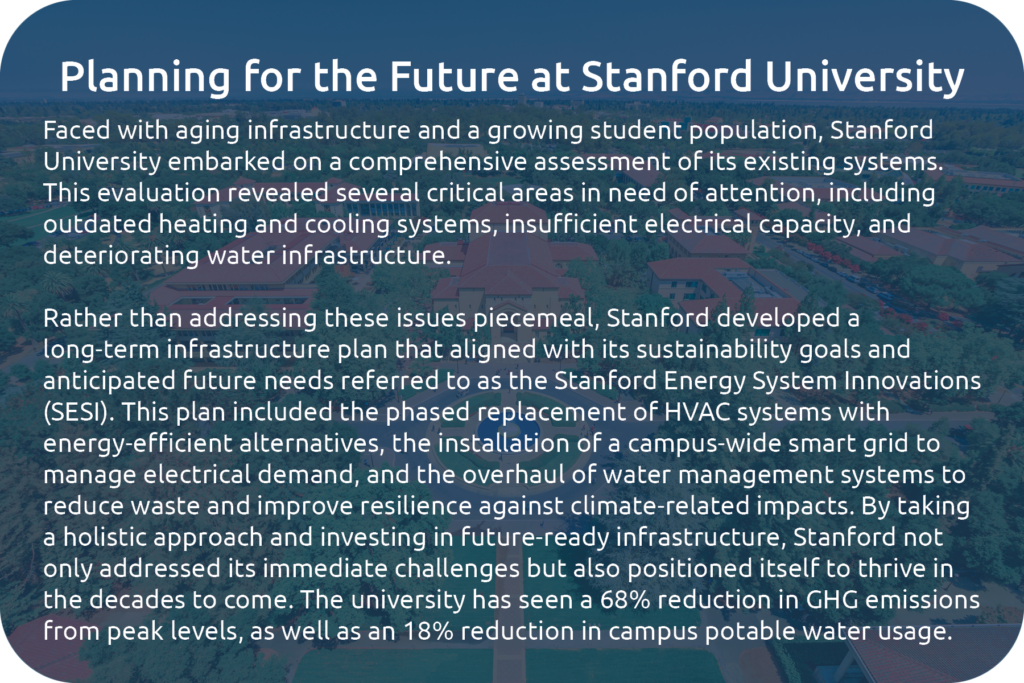- All Posts
- Future-Proof Planning: Billy Shakespeare had it Right!
Future-Proof Planning: Billy Shakespeare had it Right!
“It is not in the stars to hold our destiny but in ourselves.” – William Shakespeare
In this time of technological advancement, resiliency needs, and evolving regulatory landscapes, the need for building owners to thoroughly understand their current systems and anticipate future infrastructure needs has never been more critical. The buildings we manage today not only need to meet present demands but also be adaptable to the challenges and potential of tomorrow. This proactive approach is vital in ensuring that facilities remain resilient, efficient, and capable of supporting the well-being of their occupants.
Understanding the current state of building systems is the first step to achieve the best future-proofed facilities. Too often, building owners and operators are faced with outdated, inefficient systems that are ill-equipped to handle the growing demands of modern use. These systems may operate under the radar, functioning just well enough to avoid immediate attention but harboring potential risks that could lead to costly failures, energy inefficiencies, and even safety concerns. By taking the time to thoroughly assess and understand these systems, building owners can identify vulnerabilities and opportunities for improvement, setting the stage for strategic upgrades that align with long-term goals.
Assessing the Current State of Building Systems
The importance of a comprehensive assessment cannot be overstated. A deep dive into the existing infrastructure—including HVAC systems, electrical grids, water management, and resilience integrity—provides critical insights into how these systems are performing and where they may be falling short. For example, a detailed evaluation of a building’s HVAC system may reveal that it is not only consuming excessive energy but also failing to provide optimal air quality for occupants. This discovery can lead to targeted upgrades that improve energy efficiency, reduce operating costs, and enhance the overall indoor environment.
Moreover, understanding the current state of building systems enables owners to prioritize investments. In a world where budgets are often constrained, knowing which systems pose the greatest risks or offer the most significant opportunities for improvement allows for more informed decision-making.

Anticipating Future Infrastructure Needs
Once the current state of building systems is well understood, the next step is to anticipate future infrastructure needs. This forward-focused approach is essential for ensuring that facilities can adapt to changing demands, whether driven by technological advancements, regulatory changes, or shifts in space use.
Consider the growing importance of resiliency and energy efficiency. With increasing pressure to reduce carbon footprints and comply with stricter environmental regulations, building owners must think beyond traditional systems and explore innovative solutions that support these goals. The integration of renewable energy sources, such as solar panels or geothermal systems, can significantly reduce a building’s reliance on fossil fuels, lowering both operational costs and environmental impact. Similarly, the adoption of smart building technologies can enhance the efficiency and responsiveness of building systems, making them more adaptable to future needs.
The Role of Building Owners in Driving Change
At the core of successful future-proofing is the recognition that building owners are not merely the overseers of physical assets but stewards of the environments in which people live, work, and interact. This role carries with it a profound responsibility to ensure that these environments are safe, resilient, and capable of meeting the needs of present and future generations. By taking a proactive approach to understanding and upgrading building systems, owners can drive positive change, creating facilities that are not only more efficient and resilient but also more aligned with the broader societal goals of sustainability and well-being. By starting with smaller pilot projects and cost-benefit analyses, you are able to get not just a better understanding of your facilities, but of how they could grow and change in your favor.
As part of this responsibility, we encourage owners to reach out to firms like Viridis Initiative whose position and expertise allow for future-proofing improvements no matter the budget or needs. We understand that sometimes the most difficult part of a process is starting it. Our team specializes in providing any and all needs for your projects, from evaluation and financing, to project delivery and maintenance. At Viridis, we believe in creating resilient and dependable infrastructure projects that future-proof your facilities for the benefit of the communities you support.